Serial and parallel connection of sockets: a loop and a star
The performance of routine household duties is greatly facilitated by numerous technical devices and equipment. “Tireless workers” illuminate the premises, wash, whisk, bake, wash dishes instead of us. However, just buying them is not enough, the equipment must be correctly connected, agree.
Remember how many negative emotions a triggered machine triggers, which cuts off the line due to overload at an extremely inopportune moment. A very little pleasure is given to a damaged boiler, computer, refrigerator. But the listed troubles can be trivially prevented and generally excluded, which we are happy to help.
To do this, you just need to find out how the parallel and serial connection of outlets for home appliances is made, in which cases the "loop" and "star" circuits are used. This very useful information will be introduced by our article.
The content of the article:
Ways to connect outlets
Today, sockets are connected in two ways: in the first, a separate wiring line is arranged for each point, in the second, several points are connected to one branch at once.
The type of installed sockets is closely related to the type of wiring: whether single-phase sockets equipped with grounding or without it are used, or whether three-phase devices are installed to power devices that operate with a voltage of 380 volts.
The vast majority of technical devices that need to be connected to the power supply are located or confined to the kitchen and bathroom:
Sockets for powerful consumers, for example, electric ovens or boilers, are connected in a separate line. Whenever possible, they use integral pieces of cable during installation, devoid of any connections. Power lines are laid separately from the shield to each point, which somewhat resembles the rays emanating from the star in a pattern.
If it is necessary to connect each such consumer, the powered point must withstand a rated current of 16 - 32A. For a current with the same indicator, it is designed and standing at the input circuit breaker.
A loopback connection is selected if it is necessary to power electrical outlets of the same group. These groups are formed in accordance with the arrangement of household appliances.
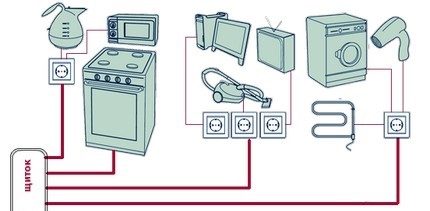
The method involves the connection of all elements to a common power supply line.
To reduce the risk of incapacitation of several points at once, the masters recommend that no more than two or three outlets be included in one system. This moment is clearly spelled out in SP 31-110-2003: up to three additional power consumers are allowed to be connected by a loop.
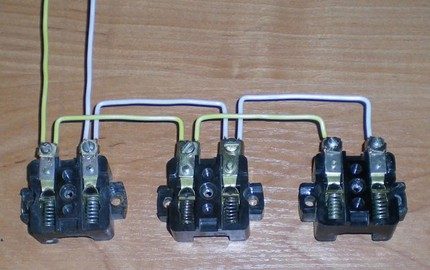
The only condition is that the total current load does not exceed twice the value of the working rated current of the first (main) power receiver.
But, in any situation, the circuit created in this way is designed for a load, the total indicator of which does not exceed 16A. Failure to comply with the operating conditions is likely to create emergency situations.
When connecting outlets, it is not at all necessary to use a clean type of wiring. With a competent approach, they can be combined, for example, bring the power cable to junction box. And after it send one cable in the form of a loop, the other lead separately to the point of supplying powerful equipment in the house.
The number of supply lines laid from the shield depends on how many wiring routes are planned to be laid.

Regardless of the type of method selected, wiring can be performed in one of two options:
- open - involves laying wires on the wall surface;
- closed - involves hollowing out channels for laying power lines in concrete and brick walls, sampling a channel in wood for laying a cable drawn into a corrugated pipe.
The open version is more convenient and simpler regarding not only installation, but also maintenance and control.But regarding the aesthetic aspect, an open wire is not always appropriate. Yes, and besides open installation method “Eats” part of the usable area: it’s impossible to hang a shelf on top of the cable or move furniture close to the wall.
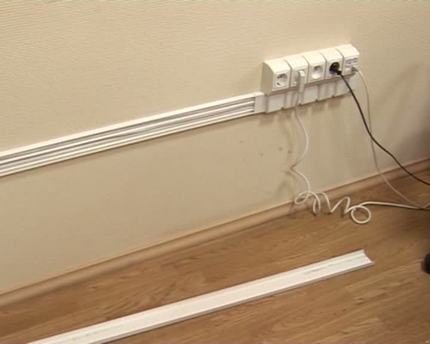
The interior of most cable channels has partitions between which it is convenient to place wires. Monitoring the state of the track is carried out through the upper removable part.
A closed wiring option is convenient in that it eliminates the possibility of accidental damage to the cable, making it invisible to others.
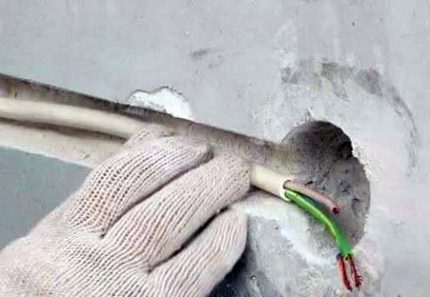
But the "invisibility" of closed wiring can play a trick on trying to "hammer a nail." Therefore, there is an unwritten rule: lay wires relative to outlets strictly vertically or horizontally.
Features of installing a loopback connection
As already noted, the loop method is used to connect outlets in the same group that power low-power devices, such as a computer, audio equipment ...
This type of connection is more economical and technically simpler. Indeed, for its implementation there is no need to lay a lot of cables and use additional protection. But it is worth noting that each additional point of the created chain will make it more vulnerable.
For example, we know that the rated current per outlet should not exceed 16A. If you connect such a load to one point, then nothing bad will happen. But when you turn on such a load at least 2-3 outlets of one line, its total readings will increase, as a result - the power cable may not withstand.
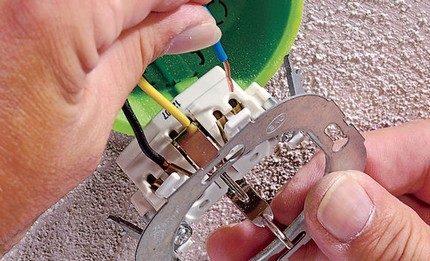
According to the PUE, with a loop connection it is not allowed to break the PE conductor of the protective grounding wire. In any case, its outline must remain inextricable.
The use of one of the technical solutions helps to reduce material costs when connecting a PE conductor to sockets:
Connector Mounting
This type of connection is chosen if necessary to connect sockets that are located almost close to each other.
With a loop connection, the trunk wire, supplied from the power shield, enters the seat of the multi-seat socket. From it, he feeds the first outlet, from which through his own contacts the power goes to the second outlet, from the second to the third.
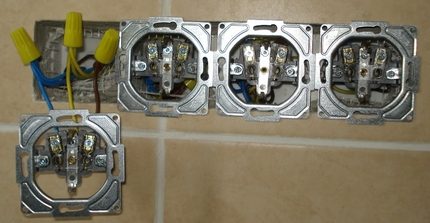
When installing a cable, the incoming and outgoing cables are connected directly to the contact part of the device. For this reason, masters recommend using models equipped with a flat spring contact.
In extreme cases, samples whose contacts are made in the form of a plate pressed by a bolt are suitable. Devices in which an ordinary bolt plays the role of a contact are not at all suitable for this purpose.
One of the mandatory operational requirements when connecting sockets with a loop is the need to reduce the transition resistance in the circuit between the contact terminals of the socket and the contacts of the electrical plug.
To achieve the desired effect, the terminals are given shapes that allow you to increase the area of the contacts themselves, as well as the strength of their compression. Today, Scotchlok connectors are often used to install protective zero. This type of clip connector is equipped with mortise contacts.
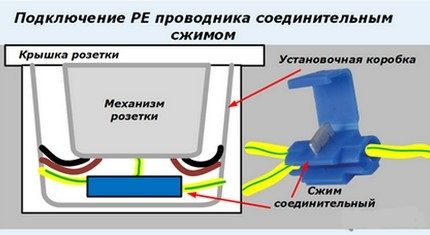
To use a clip-on connector, you should select products that provide additional space for its placement.
Through the contact of the first outlet, the phase wire of the supply cable and the PE conductor of the loop, coming further to the second outlet, are fed. On the second contact are the neutral wires of the power cable and a loop to the second outlet. By the same principle, they connect to the third and subsequent outlet, if its presence provided for a power wiring diagram.
According to the PUE p. 1.7.144 for connecting the open conductive part of the device to the neutral or grounding conductor, it is necessary to branch in the cavity of the wiring of the wiring accessories intended for this purpose. These include sockets.
The main task when connecting outlets equipped with grounding is to ensure reliable connection elements throughout the line. After all, if the ground contact for any reason burns out in the head power outlet, all other participants in the circuit will lose the protective zero. And therefore, if necessary, branches of the grounding conductor use the most reliable type of connection - crimping.

The method involves, in addition to the usual twisting of wires, additional insulation and crimping of their ends with a sleeve. This ensures uninterrupted contact of the circuit elements and its high mechanical strength.
Installation of an additional junction box
This method involves the installation of a junction box connected to the shield of a branch box or a connecting block next to the loop of sockets. In this case, the cable branches in the junction box on the site until it is brought to the socket.

Connections within the branch box leading to each outlet are most often made by welding. The insulated ends of all conductors are recommended to be laid in junction boxes so that they do not intersect and do not touch each other.
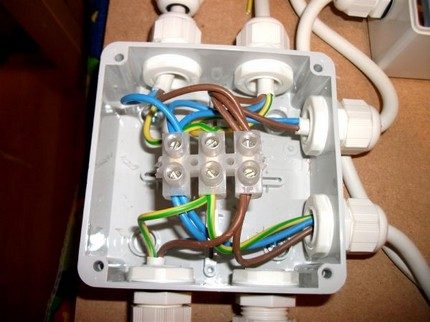
In both cases, when a phase and zero are connected to the sockets of the wires, a loop is formed, and a branch from the PE conductor. Therefore, when looping outlets, it is important to observe the polarity of the contacts: remove the zero from the terminal with a zero conductor. Do the same with the phase wire.
Given the number of working electrical appliances, the number of sockets in the room can reach 10 pieces. Using tees and extension cords is not always convenient, and it’s also dangerous. In this case, they solve the problem by installing outlet blocks instead of a single outlet.
The design of the outlet block, including up to four separate elements, is connected in the same way as a single outlet.
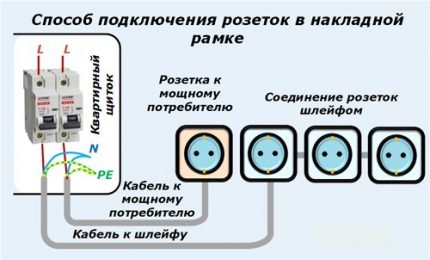
When connecting the blocks, the conductors are connected by any of the methods described. The exposed areas are insulated with a heat-shrinkable tube or wrapped with insulating tape.
Parallel Connection Specifics
A feature of the parallel socket connection scheme, otherwise called the “star”, is a separate connection to the shield of each socket.
The third well-founded name is “unmanned”, because suggests the possibility of rejection of the junction box.The method is actively practiced in European countries, and we use it to provide powerful consumers with a separate line, most often in combination with loop technology.
One of the options for a parallel circuit shows a selection of photos:
Plus “stars” in ensuring the maximum degree of security. A significant advantage is the creation of the ability to individually manage large energy consumers, which is a priority for power wiring for “Smart home”, eg. The minus of the circuit lies in the impressive labor costs of the electrician and in almost three times the cable consumption.
A parallel circuit is also used to connect three-phase power sockets that will power powerful electrical appliances. At the same time, the cross section of the cores supplying such consumers should be at least 2.5 square meters. mm
For greater reliability, they should have a small current margin. This will make it possible to compensate for the actual deviation from the diameter indicated by the manufacturer from their nominal value, which often “sin” products on the market today. In addition, this solution will provide the ability to operate equipment in overload mode.
This installation method is advantageous in that the operability of each individual point does not affect the functioning of the other participants in the circuit. For household appliances, such a scheme is considered the most stable and safe.
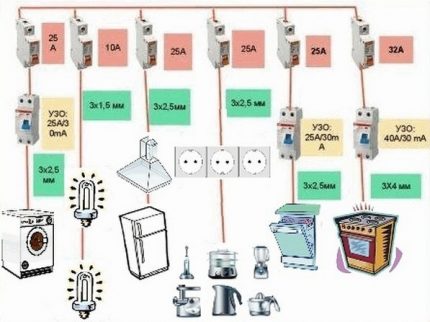
Connecting a three-phase outlet, equipped with grounding, is performed using a separate four-wire wiring. The cable, which includes three phases, grounding and zero, goes directly from the shield.
The purpose of the wire is most easily determined by the color of the insulation:
- "Phase" - wires with a white tint;
- “Zero” - the insulation is colored blue;
- "Grounding" is a yellow-green braid.
Grounding is essentially a protective zero. In order for it to remain such, it is necessary to ensure its reliable and constant connection throughout the line.
To connect the wires and connect to the outlet, the first thing to do is shorten their ends. The use of side cutters will allow the most accurate work. The end of each wire is stripped 15-20 mm from the outer insulation with a sharp knife.
The wire connection is performed in the following sequence:
- Remove the plastic protective cover from the outlet.
- The clamping screws are loosened by 5-6 mm.The same manipulations are done with the screw and on the ground terminal.
- The stripped ends of the wires are alternately inserted into the box, taking into account the position of the input terminals, and laid in the appropriate sockets.
- The jacks with laid wires are tightened with screws.
- A socket with connected wires is inserted into a wall niche and fixed with side clamps.
To obtain a more reliable assembly, some masters twist the bare ends of the cores in the form of a loop or ring so that their diameter matches the size of the legs of the screws.
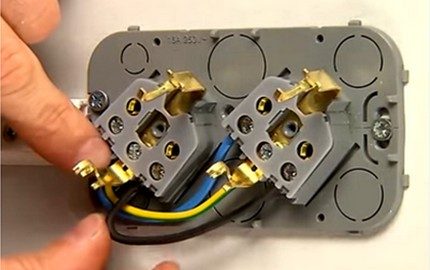
After that, each screw is unscrewed in turn, its base is wrapped with a wire ring and tightened tightly.
At connecting outlet blocks all the advantages of the circuit are preserved. The only thing is that the connection process takes a little more time and effort.
Increased costs are not an argument for those for whom safety is a priority. If you look at the situation more globally, it is sometimes better to immediately invest more money and effort by equipping an autonomous power line for the outlet. Then every time you don’t have to think about whether it is possible to use a point to connect a particular appliance.
Conclusions and useful video on the topic
Video # 1. Guidelines for the application of the loop method:
Video # 2. Detailed familiarization with one of the safe options for connecting outlets:
Provided that the amount of energy spent on household needs is increasing every year, and therefore the requirements for the reliability of outlets will certainly increase, preferring to still follow a parallel wiring diagram. Especially when it comes to serious energy consumers.
To power luminaires, electric alarms and similar devices, the option of connecting with a cable is suitable.
There were questions on the topic of the article, discovered flaws in the information presented, is there a desire to share experience in independent wiring? Please write a comment in the box below.

 How to connect an outlet block: installation rules and connection diagrams
How to connect an outlet block: installation rules and connection diagrams  Placement and installation of sockets in the kitchen: the best schemes + installation instructions
Placement and installation of sockets in the kitchen: the best schemes + installation instructions 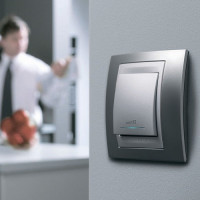 Installation height of sockets and switches: where and how to position?
Installation height of sockets and switches: where and how to position?  Installation of sockets in the bathroom: safety standards + installation instruction
Installation of sockets in the bathroom: safety standards + installation instruction 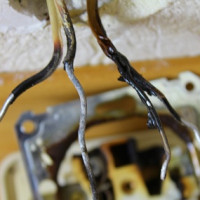 Common Outlet Malfunctions: How to Fix an Outlet Do It Yourself
Common Outlet Malfunctions: How to Fix an Outlet Do It Yourself 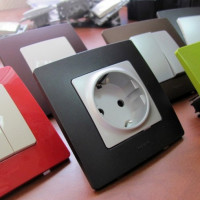 Types of electrical outlets and switches: what are and how to choose wisely
Types of electrical outlets and switches: what are and how to choose wisely  How much does it cost to connect gas to a private house: the price of organizing gas supply
How much does it cost to connect gas to a private house: the price of organizing gas supply  The best washing machines with dryer: model rating and customer tips
The best washing machines with dryer: model rating and customer tips  What is the color temperature of light and the nuances of choosing the temperature of the lamps to suit your needs
What is the color temperature of light and the nuances of choosing the temperature of the lamps to suit your needs  Replacement of a geyser in an apartment: replacement paperwork + basic norms and requirements
Replacement of a geyser in an apartment: replacement paperwork + basic norms and requirements
In the parallel circuit in the figure, use automatic machines at 25A for a wire with a cross section of 2.5. Although in the text you are talking correctly about the use of 16A machines. I think it’s worth fixing it, otherwise it’s misleading.
Andrei have you tried reading? It is a question of using machines not less than 16 A, and not the specific use of 16 amperes. It was simply stripped from the installation manual, which says about connecting the outlet groups through automatic machines from 16 A.
Recently I decided to eliminate the shortcomings of electricians who in the distant past connected sockets in my apartment, and spent several more sockets. As for me, the simplest and rather reliable way is to connect the outlet in a patch frame. The main thing is to insulate the wires, and conduct the heat-shrinkable tube carefully, without hooking the cable in the wall when attaching it. And the tube itself should look appropriate and aesthetically pleasing in the room.
Well, once again I am convinced precisely that it is better to entrust the installation of sockets to a professional electrician. It is clear that we all know how to repair wiring, but it is with the calculations that problems arise.You just need to consider that now the number of devices and their power have increased significantly. That is why it is advisable in all old houses to completely replace the wiring along with wiring points. By the way, I personally prefer outdoor wiring precisely because of the ease of inspection and repair.
Igor, I do not agree with you. The power is constantly decreasing: compare the lamp TV and LCD, incandescent lamp and LED. And so almost everywhere.
And where excuse me do you see the demotion? New Plasma Panel 52in / 132cm - 197W. LED panel 52 inches / 132 cm - 120 watts. Color tube TV "Rubin 714" (1967) 17 inches / 43 cm - 200 watts. Kinescope TV 32 inches / 81 cm - 80 watts.
And we will take into account that under the Communists as much as possible 1 TV, 1 iron was turned on at the same time, well, let’s hit the extreme - 1 soldering iron and 5 100-Watt bulbs. Calculate the power consumption, if you give advice, can you? And let’s take the current apartment: a telly in the room, a telly in the kitchen, I won’t count bulbs - you shouldn’t count a trifle.
A man came out, cut a kettle, cut a microwave, there’s a machine washing it. We already get 6 kilowatts, which gives a load of 27 amperes. Old wiring to the apartment was carried out with a 2.5 aluminum wire. Can you say vskidko - stretch or not ?!
Answer to Alexander - what’s the minus, we take a picture from one site text from another, in the end, “And you didn’t try to read.”
16 amp socket group ... this is 3.5 kW (3520w) recommended current load on an average outlet, which can be bought at our store (if we take into account exclusively imported manufacturers). Only for Russia, 16A is marked on sockets, since in any case ours is stuck there with a kilowatt 9. And the question is, does the wiring for the cable cross section withstand such power? Take the classic or Arab 32 Amp in meringue common house in Europe 10 A and 32A (as we like to call it power) type C, D, M and G type c is designed for low power, then when type G is rated 32 A, and cable for forks marked AWG8.
For our standards, this is from 8 kW, that is, about 45-50 amperes (we do not have such a section).
Amir, it makes no sense to compare a diode lamp with an incandescent lamp, much like a Vyatka two-burner electric stove with 2 kW and a modern hob 19-12 kW, a Soviet electric kettle with 500 watts and a modern (fast) 2 kW. All devices in which there is a heating element of the TEN type - in them the power has never once decreased! TEN is evil!
I note that in many of the new homes, the wiring is done exactly according to your principle. Type of power is falling, the wire is 1.5 squares across the apartment, and then the question is why the machines are flying and the terminals are being burnt. There are requirements of GOST - multiply by 2 and do it - this is your safety. Only here in Russia in the market you can buy a power outlet for 20 rubles, while any German simply will not buy a power outlet that costs less than 10 euros, simply for the reason that security can not be cheap.
On the one hand, of course, for safety and reliability, you can lay the whole house a star, but is it advisable? Everything is simple with wiring for me - a parallel connection of each room to a separate machine, and a loop inside the room. With the exception of very powerful devices - a separate conclusion for them. And there were no problems yet.
No one, Maxim, calls for powering every socket and bulb from the apartment shield - re-read the article.
By the way, directive documents (PUE, SP) recommend allocating groups of room loads, lighting, and washing machines, electric stoves with separate lines. A screenshot of the corresponding paragraph SP 31-110-2003 - attached.
In the figure explaining the wiring in the apartment, the ratings of the circuit breakers in the lighting network and outlets to household appliances with normal electricity consumption (refrigerator, portable kitchen consumers, cooker hoods, etc.) are clearly overestimated.
The power of a chandelier with 5-7 LED lamps does not exceed 50 watts. Consequently, the current consumption does not exceed 0.3A, even taking into account losses in control devices (the so-called electronic transformer).It is permissible to set the circuit breaker to 6A. And on indoor outlets - 10A. In the kitchen - 16A. In this case, selectivity will be performed with respect to the input automaton (usually its current under the conditions of Energy metering is 16 - 25A).
And in my country house I “starred” five sockets (parallel) on one machine один They work normally, but five stranded wires with a cross section of 2.5 are difficult to fix in one slot of the machine 🙂 I’ll put another one on 16A. I don’t see any reason to put any other box for connecting wires.
Good afternoon, Vitaliy. The fact that you have "marred", of course, is not provided for by any PUE. I decided to give you a similar, but less insane and civilized version of connecting several outlets using a "wiring splitter".
Have you heard about the DIN rails, N / PE buses (this is from the category of grounding / grounding network elements)? Attached a photo with tires, so as not to explain for a long time.
You can supply a power wire to such a busbar “from above” from the introductory machine, and “from the bottom” lead wires to your sockets. No torture with fixing five wires in the terminals of the machine. There is no more selectivity than your circuit, but it will add aesthetics to the shield. Wire count only count.
Sorry, but don’t tell me what could happen? .. Two outlets are connected in parallel, one is switched on a TV, the other we use as needed (iron, extra lamp).
Now we connect the Christmas tree garland, after repeatedly turning off the lights in the house (an ordinary apartment building), when the garland was turned on, the TV turned off (for a few seconds), then it turns on again. Thanks in advance.